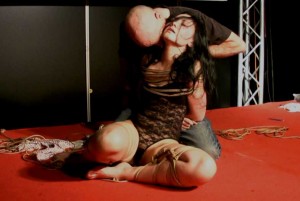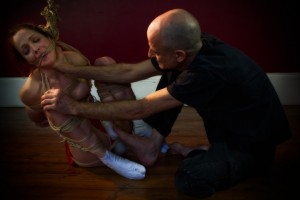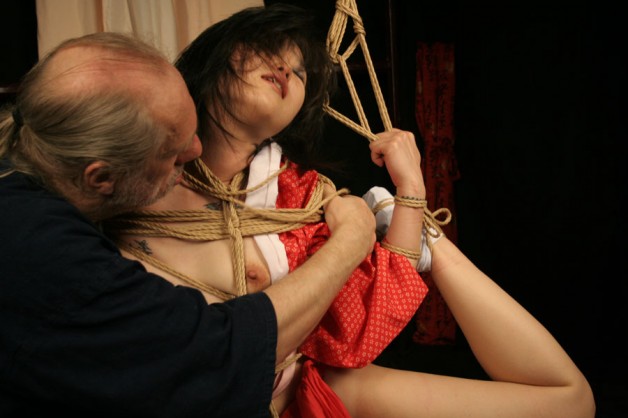Nina and I are starting to plan the second set of shibari tutorials. These will to continue from where ‘Tying people, not parcels’ left off and to develop this theme.
Some years ago, whilst discussing sex and bondage with the late Prof Petruska Clarkson of Harley Street, she said “most people treat sex like cleaning their teeth” by which she meant that it was a mechanical activity and not one that they practiced. By ‘practice’, I understood her to mean they don’t seek to improve as one might do in sport or playing an instrument. Shibari is not so much different. I don’t mean that people don’t seek to improve, they undoubtedly do but only so far. The limiting factor is largely the resources available and what people understand by the term ‘shibari’. So far, almost every tutorial has treated bondage like a mechanical exercise and has been about how to replicate patterns. I can’t recall ever seeing any tutorials, at least in English, that go beyond this ‘tying parcels’ approach. Apart from being the most authentic in terms of technique, ‘Japanese Rope Bondage’ Vols I & II broke new ground by starting to explore what makes kinbaku different from the western approach to bondage or even the Japanese-style/fusion touted by various household names that many call ‘shibari’. Furthermore, as far as I’m aware, nobody goes into as much depth about the nuances of ties like the deceptively complex box-tie (takate-kote). You can the see the lack of depth that I’m talking about in existing tutorials by my comments on the box-tie section in Complete Shibari.
 Shibari is not about knots or pretty patterns, it is about what you communicate with the rope when you make them. A lot of people say “Getting tied up is the boring bit“. My reply is “You are not being tied properly“. What they are saying is that the way the rope is being applied is not turning them on… unless they are immune to sensuality, eroticism, domination and SM and that appears to be a fairly rare condition in my experience. Thus, I do not intend to teach a lot of ties as recipes. Whilst ‘recipes’ can be useful exercises to develop standard skills, they do little to enhance creativity. It is better to fully understand how ingredients can be used. Armed with that knowledge, one can invent ones own recipes and competently reverse-engineer others. There is a big difference between knowing how to follow the pattern required to make an X or Osada half-moon friction and knowing what a friction does and how to create that function. If you just follow the pattern without adequately compacting a friction, it won’t do its job. However, even something like the way you tie a specific friction can create a different feeling in the person being tied. The speed, tempo and tension of the rope when you tie are as important as the annotations on a musical score. Imagine how music would sound as a simple list of notes without any guide to the way it should be played. From my perspective, this is how shibari is being taught and in many cases not even with the right notes. The new DVDs plan to change this and set any entirely new agenda by going into how you tie, rather than just what you tie, in unprecedented depth.
Shibari is not about knots or pretty patterns, it is about what you communicate with the rope when you make them. A lot of people say “Getting tied up is the boring bit“. My reply is “You are not being tied properly“. What they are saying is that the way the rope is being applied is not turning them on… unless they are immune to sensuality, eroticism, domination and SM and that appears to be a fairly rare condition in my experience. Thus, I do not intend to teach a lot of ties as recipes. Whilst ‘recipes’ can be useful exercises to develop standard skills, they do little to enhance creativity. It is better to fully understand how ingredients can be used. Armed with that knowledge, one can invent ones own recipes and competently reverse-engineer others. There is a big difference between knowing how to follow the pattern required to make an X or Osada half-moon friction and knowing what a friction does and how to create that function. If you just follow the pattern without adequately compacting a friction, it won’t do its job. However, even something like the way you tie a specific friction can create a different feeling in the person being tied. The speed, tempo and tension of the rope when you tie are as important as the annotations on a musical score. Imagine how music would sound as a simple list of notes without any guide to the way it should be played. From my perspective, this is how shibari is being taught and in many cases not even with the right notes. The new DVDs plan to change this and set any entirely new agenda by going into how you tie, rather than just what you tie, in unprecedented depth.
 Volume III will start by revising the 2-rope takate-kote (box-tie) but with far greater emphasis on the ‘how’ and then, by popular demand, move on to adding the third rope. We will also introduce other ties, including some new ones like Nina’s hip-harness which is far more solid than the Japanese versions I have seen, yet still retains the look and speed of tying. I will use these examples to demonstrate numerous very advanced techniques learned from my own observations and from some of the world’s most acclaimed ‘bakushi such as Yukimura Haruki, who is Osada Steve’s sensei and acknowledged king of newaza (caressing style floor-work). One example is the effects of his control of the ‘nawa giri’ (rope end). I shall also be adding a few new ideas of my own, e.g. ‘3-point contact’, which breaks the rope down into 3 parts, each with their own tactile possibilities. The plan is to really get into what makes shibari into connective kinbaku and not ‘just tying parcels’. As Wkyd-Dave puts it, “I don’t do rope, I do people with rope“. If that’s what you want to do, this is the tutorial you have been waiting for. These are the secrets known only to the most advanced practitioners.
Volume III will start by revising the 2-rope takate-kote (box-tie) but with far greater emphasis on the ‘how’ and then, by popular demand, move on to adding the third rope. We will also introduce other ties, including some new ones like Nina’s hip-harness which is far more solid than the Japanese versions I have seen, yet still retains the look and speed of tying. I will use these examples to demonstrate numerous very advanced techniques learned from my own observations and from some of the world’s most acclaimed ‘bakushi such as Yukimura Haruki, who is Osada Steve’s sensei and acknowledged king of newaza (caressing style floor-work). One example is the effects of his control of the ‘nawa giri’ (rope end). I shall also be adding a few new ideas of my own, e.g. ‘3-point contact’, which breaks the rope down into 3 parts, each with their own tactile possibilities. The plan is to really get into what makes shibari into connective kinbaku and not ‘just tying parcels’. As Wkyd-Dave puts it, “I don’t do rope, I do people with rope“. If that’s what you want to do, this is the tutorial you have been waiting for. These are the secrets known only to the most advanced practitioners.
Vol IV will expand on the subject of floor based suspension broached in the ‘Tying people, not parcels’. Some of you might be disappointed that the tutorials don’t cover full suspension and might wonder why. Firstly, Japanese suspensions are not to be taken lightly. They need a lot more care and shorter duration than western or fusion style ties which generally provide a lot more support to multiple points that are fairly hard to damage. Furthermore, shibari suspensions are likely to more dynamic and involve transitions. Many of the techniques are not suitable for everyone and can be extremely demanding of both parties. In short, full Japanese suspension is a very advanced skill so is not something to be rushed in a short video tutorial. I feel it would be very irresponsible to skimp on the teaching. There is a lot of ground work, literally, before one can suspend with an acceptable degree of safety. I say “an acceptable degree of safety” as there is no such thing as a 100% risk free bondage suspension. It is always RACK, it is edge play and not SSC. Get it wrong and the downside can be serious and even fatal. In my opinion, full suspension is a big distraction and vastly over-rated, unless you plan a career in performance bondage. If ‘circus bondage’ is your chosen path, there is even more reason to have solid base skills.
 Floor based suspension allows much more extended play than full suspension and is much safer due to the lower stresses and loads. It still permits most of the same opportunities for creating beautiful poses, exposure, enforcing practical positions or inducing stress or discomfort. In some cases, it offers even better possibilities. In terms of training, it provides many of the same challenges and develops the skills that are inherent in full suspension but, importantly, with reduced load and less serious consequences if you get it wrong. If something fails with your partner on the ground it is likely to be less catastrophic than if they are hanging in an inversion! As they say in aviation, “There is no such thing as an accident, only pilot error“. That might be a bit harsh but I hope you get my drift. Again, some very high level techniques will be taught that are well beyond anything yet covered in published tutorials that are the result of years of experience and personal tuition by some of Japan’s best. It is hoped that the next two volumes will raise the bar yet again and lead to a far greater understanding that shibari is not just about knots, exotic macrame or simply a matter of repeating steps. A technically perfect 3-rope takate-kote is not a magic spell that will automatically send your partner into ecstasy but one rope used to full effect could easily. It is how to use rope that I plan to teach.
Floor based suspension allows much more extended play than full suspension and is much safer due to the lower stresses and loads. It still permits most of the same opportunities for creating beautiful poses, exposure, enforcing practical positions or inducing stress or discomfort. In some cases, it offers even better possibilities. In terms of training, it provides many of the same challenges and develops the skills that are inherent in full suspension but, importantly, with reduced load and less serious consequences if you get it wrong. If something fails with your partner on the ground it is likely to be less catastrophic than if they are hanging in an inversion! As they say in aviation, “There is no such thing as an accident, only pilot error“. That might be a bit harsh but I hope you get my drift. Again, some very high level techniques will be taught that are well beyond anything yet covered in published tutorials that are the result of years of experience and personal tuition by some of Japan’s best. It is hoped that the next two volumes will raise the bar yet again and lead to a far greater understanding that shibari is not just about knots, exotic macrame or simply a matter of repeating steps. A technically perfect 3-rope takate-kote is not a magic spell that will automatically send your partner into ecstasy but one rope used to full effect could easily. It is how to use rope that I plan to teach.
We are at the early stages of drawing up an outline right now so we won’t be shooting it for a while. Hopefully, we will start filming in the first quarter of next year and we will have planned it sufficiently well to complete it in a few days. That reminds me, I must call a film crew I know from working with them. Anyway, you can be sure that regular progress reports will be posted.

